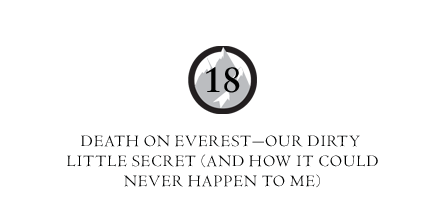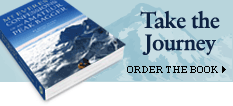Read an Excerpt
| Chapter 18 | |

It could never happen to me. Thatís what you think. If I truly believed I was going to die climbing, I wouldnít go. When Mr. Liggett fell to his death, I had to do a lot of soul searching.
Up until that point, the closest Iíd come to death on the mountain was when we were digging around for our gear cache at 19,400 feet on Aconcagua in 1995. I thought Iíd found what we were looking for, but when I pulled back the tarp, I found a human hand. I could see the outline of a body under the snow. Then I noticed the ring finger on the hand that was exposedóthe dead climber was wearing a wedding band. It was an extremely sobering moment.
As a mountaineer, you accept risk. You feel you can manage it. You try not to go in avalanche areas. You go in the Icefall early when itís safer. And if youíre not feeling up to it, maybe you rest for another day. You always feel as though it could never happen to you. For most pilots who meet misfortune, it happens before they take off. Itís the same in the mountains. It comes down to bad decision-making. Obviously, I accept a reasonable amount of risk with some of the things I do. Everyone has different levels of risk management. There are days when people climb with a lenticular cloud hanging over the mountain and you go, "Oh, my gosh, I would never do that." You think, "Iím smarter, tougher, better. Whatever." Thatís true and false. The bottom line is, it can happen to you. You can do everything right and still die. You have to think about death and the possibility that it might occur. But you canít dwell on it.
If a big hanging serac falls on your head in the morning, even if itís early in the morning and youíre walking lightly, well, I guess your number is up. When Mr. Liggett fell I found myself asking, "Is this fair to Maggie?" I was looking at fresh blood and the reality that a party of five went up, but only four came back down alive. That was a human being, not a statistic you read on a page and dismiss.
Does the death of a climber, albeit a stranger, stop you? Obviously, it doesnít. Weíre selfish. But this was supposed to be fun. Even though you get your butt kicked occasionally, overall itís a joyful experience. But this cast a grim cloud over the expedition for days. It made us realize, "Yeah, it could happen to me." Then, after a little time, you collect yourself. You decide, "OK, either Iím going to go home and quit this silliness or Iím going to double my concerns and attention to safety and learn from this." Thatís how we took it. After a couple days of self-doubt, I reinsulated myself that it couldnít happen to me.
I went on.
Hereís our dirty little secret—If no one ever died on Everest, it would not be as big a deal to climb it. If there werenít a high degree of risk involved, there would not be as high a degree of reward.
Almost anything you do thatís high risk, has a high reward. And thereís a fine line between success and failure. If youíre an entrepreneur, the difference between doing great and not paying your bills is pretty slim. Itís the same way with flying. They say that when shooting an instrument approach in the clouds, your brain is seven times more amped than a brain surgeon who is operating. But if you screw up and slam into cumulus granite, people think, "The fool." If you land without incident, people say, "Wow, what a good pilot." Same thing with climbing. People always asked, "Did you make it?" No one said, "Did you have a good time? Did you get along well? Was everyone in harmony?" Itís "Did you make the summit?" The summit is invariably the measure of your success. So, obviously, we all failed quite a bit—or at least it was perceived that we failed.
You did have to accept a level of risk and understand that death could happen to you, while at the same time believing it couldnít happen to you. You appreciate life so much more once you realize how precious and precarious it is. Thatís one of the things you get out of climbing. You realize it could be taken away. A lot of climbing is down time. But when you are doing something, you are super dialed in. Youíre consumed with it.
Thereís a little bit of that man vs. self and man vs. nature when you climb a big mountain. Iím not sure a lot of mountaineers would say it, but putting yourself in a dangerous place excites people and they know it. Nobody goes to see a tightrope walker one foot off the ground. They want to see someone on the wire high off the ground. Maybe the thickness of the rope is the same, but itís cooler when theyíre higher. Why? Threat of death, I guess.
If Jon Krakauer, who is a great writer, had gone and climbed Mount Everest and nothing bad had happened, he would have written a good book. But how many millions would he have sold? When the disaster of 1996 struck Everest, the worldís attention was riveted on it. Into Thin Air became a gigantic bestseller. Same thing with David Breashearsí IMAX film. Without the tragedy it would have been an absolutely epic case of film making, but fewer people would have gone to see it. Itís awful to say, but those are the facts.
Even so, while death is a part of Everest, it is not the ultimate reason why we climb it. We donít have a death wish. If Iíd taken the big bivouac nap up there, then some people would have said quietly that I was a selfish jerk. Others would have said, "He died doing what he loved." Thatís the great write-off. You donít want to die doing what you love. You want to love what youíre doing and die an old man.
When I returned to Base Camp, I called Maggie at home. In my journal on May 1, I wrote:
I was afraid she had heard of the tragedy and was freaking. I got her at work and she sounded great. She had heard about the high winds from an Internet dispatch, but not the death. As much as I tried I couldnít suppress my cough. She sounded concerned and also pointed out that it was now May 1. Her unspoken message to me was, "letís get this over with and carry on with our lives together." The message is clear, especially in light of the tragedy.
On the one hand weíre really well acclimatized and weíll be ready to go after five or six days of rest. On the other hand, is it really worth it? Iím not sure, but Iím going to be extra careful and Iíll turn around if it doesnít feel right.
|
Everyone loves a free sample. Choose a part of the book you would like to read from the list below. You can then download PDFs of these pages to see how the real thing looks. Front Cover Back Cover Table of Contents Chapter 5: The Decision—Don't Tell Anyone... Yet Chapter 6: FWA Chapter 17: A Camp 3 Wake-Up Call Chapter 18: Death on Everest—Our Dirty Little Secret Chapter 32: My Dad's Dying Chapter 33: Here We Go Again |

